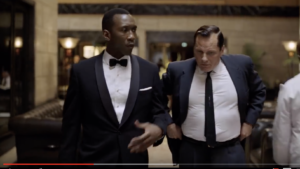Mondays with Mike: Wonderment never gets old
December 10, 2018 • 2 Comments • Posted in Mike Knezovich, Mondays with MikeNASA InSight Mission crew celebrates the successful landing on Mars.
Back in grade school, there were exciting days when our teacher would wheel a battleship-grey cart carrying a big black-and-white TV into the corner of our classroom. The teacher would tune to CBS and Walter Cronkite, or sometimes to ABC and Jules Bergman, and together, we’d watch a manned space mission blast off from Cape Canaveral.
Whether at school or at home, I always, always watched those blastoffs in wonder.
I followed every EVA (extravehicular activity, or space walk as they were more commonly called) and knew that every thing they were doing was designed to test what needed to be tested to go farther—to the moon. I was a heartbroken 10-year-old when my favorite astronaut, Gus Grissom, was one of three astronauts in training who died in a flash fire. Finally there was Apollo 8, when we first orbited the moon and earth got its first selfie, and 9 and 10, which got oh so close. I kept thinking, why don’t we just land there already?
At last, my family and I huddled around the TV for the Apollo 11 moon landing and walk.
Years later, the company I worked at put on an employee event and had James Lovell speak about his book “Lost Moon,” on which the movie “Apollo 13” was based. I usually tune out motivational speakers at corporate events. Not this time. The story about how much a group of people working together can accomplish really resonated.
When I recall the space race days, I tend to use language like, “When we landed on the moon,” “when we walked in space.” Because, as a kid, it felt that way. “We” as in the USA. “We” as in Americans. “We,” as in we all had a stake in it, and all of us (well, our parents) funded this endeavor.
Those were turbulent times culturally and divisive times politically. Each mission provided a kind of a time-out, an oasis. We were all looking in the same direction, and pulling for the same team. Those moments were otherwise few and far between.
Interest waned. Ho-hum, space. The Shuttle program, which was wrought with problems from its conception, didn’t spark the wonder that the early missions did.
Still, I’ve maintained a passing interest in our space program, enough that I was tracking the NASA InSight Mission landing on Mars this past November 26. I got those old familiar feelings: of awe, of pride, of us.
The landing was a phenomenal accomplishment—the mission launched back on May 5. But in a real way, it was just the latest pinnacle of accomplishment built on the discoveries, curiosity and hard work of humankind. You can draw a line from Mars back to Newton and Galileo. It depends on generations of hard work and steady advancement in a zillion fields.
The InSight Mission goes on, and the data and images roll in. You can track it here. If you need a break from cable news, social media, or the headlines, and you need a shot of inspiration, give it a look and fly away to Mars for a while.



